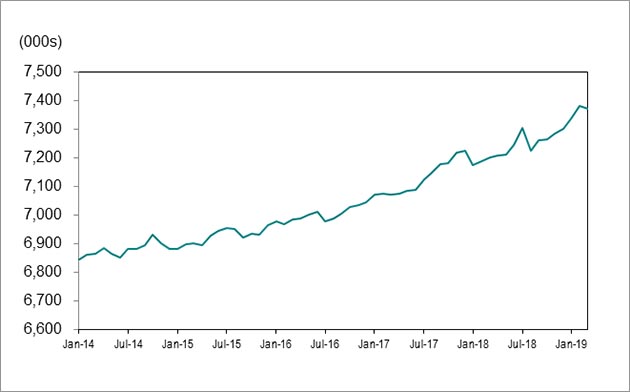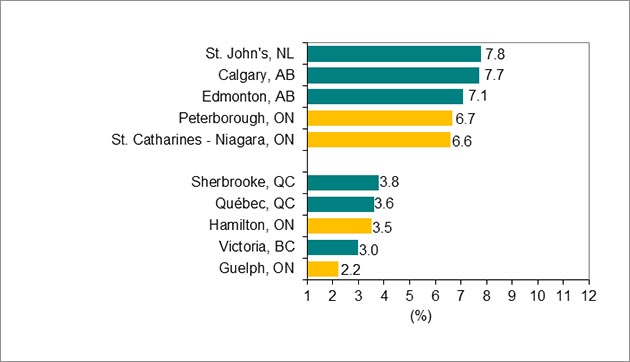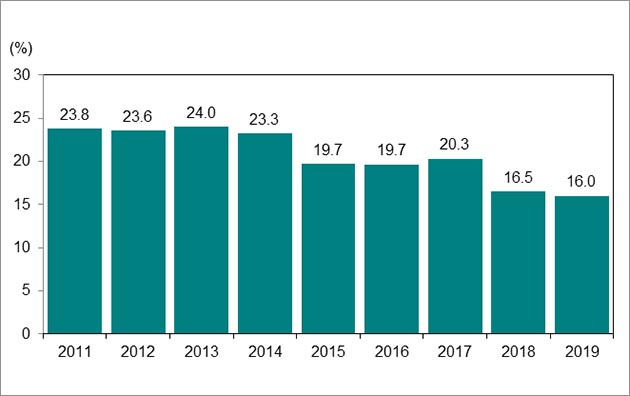Labour market report, March 2019
Employment in Ontario decreased in March. Get the details in this report.
Quick facts
In March 2019:
- There were 12.0 million people in Ontario aged 15 years or older
- 7.8 million (65%) were either working or actively looking for work
- 7.4 million (61%) were employed and 82% of them had a full-time job
- Ontario’s unemployment rate was 5.9% (460,250 unemployed people)
Employment decreased in March
Employment in Ontario decreased in March (8,800), after rising by 36,900 jobs in February.
Chart 1 shows employment in Ontario from January 2014 to March 2019.

Source: Statistics Canada, Labour Force Survey, Table 14-10-0019-01,(seasonally adjusted data).
Download data, chart 1
Full-time vs. part-time
Full-time (11,600) employment accounted for all the job losses. Part-time jobs increased (2,800).
Employment increase/decrease by age
Youth employment (those aged 15 to 24) decreased in March (11,100), after rising by 21,200 jobs in February.
Employment for people aged 25 to 54 fell by 15,900 in March, compared to February. Those aged 55 and older gained 18,000 jobs.
Employment in Canada was little changed in March (-7,200), following an increase of 55,900 jobs in February.
Unemployment rate increased to 5.9%
Chart 2 shows unemployment rates, Ontario and Canada, January 2014 to March 2019.

Source: Statistics Canada, Labour Force Survey, Table 14-10-0019-01, (seasonally adjusted data).
Download data, chart 2
Ontario’s unemployment rate increased to 5.9% in March from 5.7% in February.
Ontario’s unemployment rate has remained below 6.0% since August 2017 and has not been higher than Canada’s unemployment rate since February 2015.
Canada’s unemployment rate remained at 5.8% in March for the third consecutive month.
Unemployment rate by age
For people aged 15 to 24, the unemployment rate was 12.2% in March, up from 11.9% in February.
The unemployment rates for people aged 25 to 54 increased to 4.9% in March from 4.7% in February and to 4.8% from 4.2% for those aged 55 and older.
Lowest and highest unemployment rates
Chart 3 shows Census Metropolitan Areas (CMAs) with highest and lowest unemployment rates in Canada, March 2019.

Source: Statistics Canada, Labour Force Survey, Table 14-10-0294-01, (seasonally adjusted data three-month moving average to reduce volatility caused by small sample size).
Download data, chart 3
Peterborough recorded the highest unemployment rate in Ontario (6.7%) in March, while St. John’s, Newfoundland recorded the highest unemployment rate in Canada (7.8%).
Guelph recorded the lowest unemployment rate in Canada in March (2.2%).
Year-over-year comparisons
Over the first three months of 2019, employment in Ontario increased by 175,400 net jobs for adults 25 years and older compared to the first three months of 2018.
Employment increase and decrease by education level
Chart 4 shows Ontario employment change by highest level of education attained, aged 25 and older, March 2018 year-to-date to March 2019 year-to-date.

Source: Statistics Canada, Labour Force Survey, Table 14-10-0019-01, unadjusted data.
Download data, chart 4
Adults with a postsecondary certificate or diploma led gains with 105,400 net new jobs, while those with a university degree gained 82,400 jobs.
Individuals with some postsecondary education recorded job losses of 52,400.
People with less than high school education also recorded job losses (10,100), while those with high school education recorded job gains of 50,100.
Unemployment rate by education level
The unemployment rate for adults aged 25 and older with postsecondary education credentials was 4.4% in the first three months of 2019, up from 4.1% a year earlier.
The unemployment rate for adults without postsecondary education credentials was 6.5%, unchanged in the first three months of 2019 compared to a year ago.
Employment increase and decrease by occupation
Chart 5 shows Ontario employment change by occupation, March 2018 year-to-date to March 2019 year-to-date.

Source: Statistics Canada, Labour Force Survey, Table 14-10-0297-01, unadjusted data.
Download data, chart 5
Eight of the ten major occupational groups in Ontario had net employment gains in over the first three months of 2019 compared to a year earlier.
Learn more about the National Occupational Classification (NOC) system.
These occupations gained the most jobs:
- sales and service (50,700)
- trade, transport and equipment operator (48,700)
- education, law and social, community and government services (43,400)
These occupations lost jobs:
- management (45,100)
- manufacturing and utilities (20,600)
Long-term unemployment share decreased
Chart 6 shows Ontario’s long-term unemployed (27 weeks or more) as a percentage of total unemployment, March 2011 year-to-date to March 2019 year-to-date.

Source: Statistics Canada, Labour Force Survey, Table 14-10-0056-01, unadjusted data.
Download data, chart 6
Over the first three months of 2019, an average of 73,400 people were unemployed for 27 weeks or longer, or long-term unemployed. This was up from 70,800 a year earlier.
Long-term unemployed individuals accounted for 16.0% of the total number of unemployed people in the first three months of 2019. This compared with 16.5% a year earlier.
Average time in long-term unemployment
The average time in unemployment decreased to 16.6 weeks in over the first three months of 2019 from 17.3 weeks a year earlier.
Download data
Source: Statistics Canada, Labour Force Survey
March 2019 Labour Market Report:
- CSV, Chart 1, employment in Ontario from January 2014 to March 2019, 1Kb
- CSV, Chart 2 unemployment rates, Ontario and Canada, January 2014 to March 2019, 2Kb
- CSV, Chart 3 Census Metropolitan Areas (CMAs) highest and lowest unemployment rates, 2Kb
- CSV, Chart 4, Ontario employment change by highest level of education, aged 25 and older, 99Kb
- CSV, Chart 5, Ontario employment change by occupation 12Kb
- CSV, Chart 6, Ontario’s long-term unemployed, 15Kb